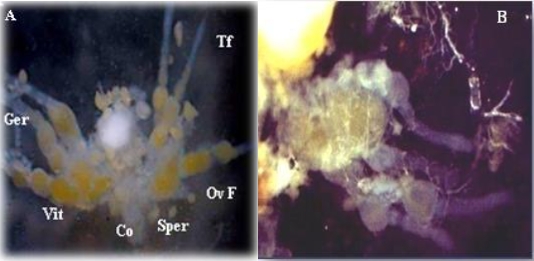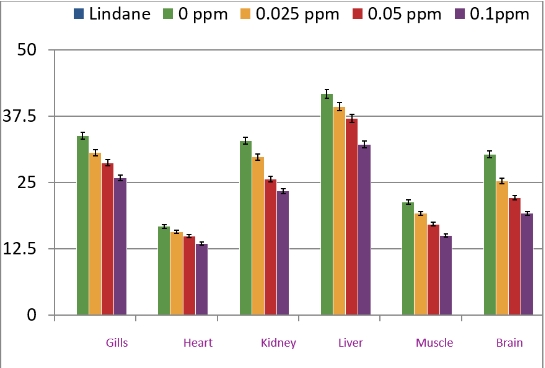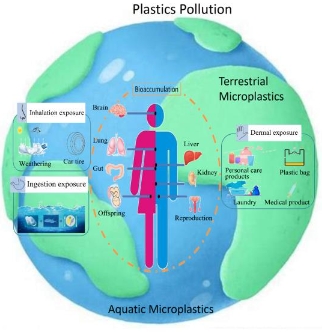A review on water pollution by γHCH (lindane) and its removal using nanomaterials
Abstract
Water pollution by the direct discharge of pollutants (fertilizers, pesticides, heavy metals, etc.) into the river without any pretreatment has become a severe environmental/health hazard. Organochlorine pesticides have extensively been used from the 1940s to 1980 as insecticides in agriculture, weedicides, herbicides, etc. Lindane, an organochlorine pesticide, contributes to bioaccumulation in aquatic organisms and biomagnification in the food chain due to its hydrophobic chemical nature and environmentally persistent property with a very slow rate of degradation. Nanotechnology has proven to be very efficient in removing pollutants. Nanomaterials with unique physical and chemical properties have become a tool for toxicant eradication. Some of the properties of nanomaterials, like high reactivity, adhesion, reflectance, surface plasmon resonance to detect toxic materials, quantum effect in which there is no resistance faced by charged particles, small size, and large surface area to volume, enable them to adsorb many toxicants on their surface, thereby assisting in detoxification and removal of pollutants from water. Some examples include the application of nano-zerovalent iron in the oxidation of groundwater, the reusability of photocatalytic membranes, and many more. This review article presents an updated account of some techniques for eradicating lindane from the aqueous medium.
References
[1]Wacławek S, Antoš V, Hrabák P, et al. Remediation of hexachlorocyclohexanes by electrochemically activated persulfates. Environmental Science and Pollution Research 2015; 23(1): 765–773. doi: 10.1007/s11356-015-5312-y
[2]Salam JA, Das N. Degradation of lindane by a novel embedded bio-nano hybrid system in aqueous environment. Applied Microbiology and Biotechnology 2014; 99(5): 2351–2360. doi: 10.1007/s00253-014-6112-x
[3]Nguyen TH, Nguyen TTL, Pham TD, et al. Removal of lindane from aqueous solution using aluminum hydroxide nanoparticles with surface modification by anionic surfactant. Polymers 2020; 12(4): 960. doi: 10.3390/polym12040960
[4]Rizwan M, Singh M, Mitra CK, Morve RK. Ecofriendly application of nanomaterials: Nanobioremediation. Journal of Nanoparticles 2014; 2014: 431787. doi: 10.1155/2014/431787
[5]UNEP. Stockholm Convention on Persistent Organic Pollutants (POPs). Available online: http://www.pops.int (accessed on 20 December 2023).
[6]UNEP. Global Report 2003: Regionally Based Assessment of Persistent Toxic Substances. UNEP Chemicals; 2003.
[7]Maddah B, Hasanzadeh M. Fe3O4/CNT magnetic nanocomposites as adsorbents to remove organophosphorus pesticides from environmental water. International Journal of Nanoscience and Nanotechnology 2017; 13(2): 139–149.
[8]Gupta A, Siddiqi NJ, Sharma B. Bioaccumulation and biochemical studies of toxicants in fish on AChE. Open Journal of Pathol & Toxicology Research 2021; 1(1): 000505.
[9]Abhilash PC, Singh N. Pesticide use and application: An Indian scenario. Journal of Hazardous Materials 165(1–3): 1–12. doi: 10.1016/j.jhazmat.2008.10.061
[10]Srivastava M, Abhilash PC, Singh N. Remediation of lindane using engineered nanoparticles. Journal of Biomedical Nanotechnology 2011; 7(1): 172–174. doi: 10.1166/jbn.2011.1255
[11]Sharma A, Kumar V, Shahzad B, et al. Worldwide pesticide usage and its impacts on ecosystem. SN Applied Sciences 2019; 1: 1446. doi: 10.1007/s42452-019-1485-1
[12]Singh T, Singh DK. Rhizospheric Microbacterium sp. P27 showing potential of lindane degradation and plant growth promoting traits. Current Microbiology 2019; 76(7): 888–895. doi: 10.1007/s00284-019-01703-x
[13]Ignatowicz K. Selection of sorbent for removing pesticides during water treatment. Journal of Hazardous Material 2009; 169(1–3): 953–957. doi: 10.1016/j.jhazmat.2009.04.061
[14]Gupta A, Sharma B. Evaluation of levels of phosphatases in the lindane exposed fish, Channa punctatus. Journal of Biomedical Research & Environmental Sciences 2023; 4(3): 555–561. doi: 10.37871/jbres1710
[15]Gupta A, Sharma B. A study on transaminases in lindane exposed fish C. punctatus. Journal of Biomedical Research & Environmental Sciences 2023; 4(6): 1100–1107. doi: 10.37871/jbres1773
[16]Gupta A. An evaluation of lactate dehydrogenase in the lindane exposed fresh water fish, Channa punctatus. International Journal of Animal Biotechnology and Applications 2021; 7(1): 9–19.
[17]Gupta A, Sharma B. Acute chronic toxicity of lindane in Channa punctatus. Open Journal of Pathol & Toxicol Research 2021; 1(1): 000501.
[18]Riu J, Maroto A, Rius FX. Nanosensors in environmental analysis. Talanta 2006; 69(2): 288–301. doi: 10.1016/j.talanta.2005.09.045
[19]Cloete TE, De Kwaadsteniet M, Botes M, et al. Nanotechnologyin Water Treatment Applications. Caister Academic Press; 2010.
[20]Bora T, Dutta J. Applications of nanotechnology in wastewater treatment—A review. Journal of Nanoscience and Nanotechnology 2014; 14(1): 613–626. doi: 10.1166/jnn.2014.8898
[21]Prachi, Gautam P, Madathil D, Brijesh Nair AN. Nanotechnology in waste water treatment: A review. International Journal of ChemTech Research 2013; 5(5): 2303–2308.
[22]El-Safty SA, Hoa ND, Shenashen MA. Topical developments of nanoporous membrane filters for ultrafine noble metal nanoparticles. European Journal of Inorganic Chemistry 2012; 2012(33): 5439–5450. doi: 10.1002/ejic.201200629
[23]Choi JH, Dockko S, Fukushi K, Yamamoto K. A novel application of a submerged nanofiltration membrane bioreactor (NF MBR) for wastewater treatment. Desalination 2002; 146(1–3): 413–420. doi: 10.1016/S0011-9164(02)00524-6
[24]Verliefde ARD, Cornelissen ER, Heijman SGJ, et al. The role of electrostatic interactions on the rejection of organic solutes in aqueous solutions with nanofiltration. Journal of Membrane Science 2008; 322(1): 52–66. doi: 10.1016/j.memsci.2008.05.022
[25]Cadotte J, Forester R, Kim M, et al. Nanofiltration membranes broaden the use of membrane separation technology. Desalination 1988; 70(1–3): 77–88. doi: 10.1016/0011-9164(88)85045-8
[26]Drewes J, Bellona C, Xu P, et al. Comparing Nanofiltration and Reverse Osmosis for Treating Recycled Water. International Water Association (IWA); 2008.
[27]Bowen WR, Mukhtar H. Characterisation and prediction of separation performance of nanofiltration membranes. Journal of Membrane Science 1996; 112(2): 263–274. doi: 10.1016/0376-7388(95)00302-9
[28]Behnam R, Morshed M, Tavanai H, Ghiaci M. Destructive adsorption of diazinon pesticide by activated carbon nanofibers containing Al2O3 and MgO nanoparticles. Bulletin of Environmental Contamination and Toxicology 2013; 91: 475–480. doi: 10.1007/s00128-013-1064-x
[29]Košutić K, Kunst B. Removal of organics from aqueous solutions by commercial RO and NF membranes of characterized porosities. Desalination 2002; 142(1): 47–56. doi: 10.1016/S0011-9164(01)00424-6
[30]Musbah I, Cicéron D, Saboni A, Alexandrova S. Retention of pesticides and metabolites by nanofiltration by effects of size and dipole moment. Desalination 2013; 313: 51–56. doi: 10.1016/j.desal.2012.11.016
[31]Jucker C, Clark MM. Adsorption of aquatic humic substances on hydrophobic ultrafiltration membranes. Journal of Membrane Science 1994; 97: 37–52. doi: 10.1016/0376-7388(94)00146-P
[32]Fryxell GE, Cao G. Environmental Applications of Nanomaterials: Synthesis, Sorbents and Sensors. World Scientific; 2012.
[33]Liu WT. Nanoparticles and their biological and environmental applications. Journal of Bioscience and Bioengineering 2006; 102(1): 1–7. doi: 10.1263/jbb.102.1
[34]Hummer G, Rasaiah JC, Noworyta JP. Water conduction through the hydrophobic channel of a carbon nanotube. Nature 2001; 414: 188–190. doi: 10.1038/35102535
[35]Wan R, Lu H, Li J, et al. Concerted orientation induced unidirectional water transport through nanochannels. Physical Chemistry Chemical Physics 2009; 11(42): 9898–9902. doi: 10.1039/B907926M
[36]Taghizade Firozjaee T, Mehrdadi N, Baghdadi M, Nabi Bidhendi GR. Application of nanotechnology in pesticides removal from aqueous solutions—A review. International Journal of Nanoscience and Nanotechnology 2018; 14(1): 43–56.
[37]Coronado JM, Fresno F, Hernández-Alonso MD, Portela R. Design of Advanced Photocatalytic Materials for Energy and Environmental Applications. Springer; 2013.
[38]Hagfeldt A, Graetzel M. Light-induced redox reactions in nanocrystalline systems. Chemical Reviews 1995; 95(1): 49–68. doi: 10.1021/cr00033a003
[39]Jeon S, Yong K. Morphology-controlled synthesis of highly adsorptive tungsten oxide nanostructures and their application to water treatment. Journal of Materials Chemistry 2010; 20(45): 10146–10151. doi: 10.1039/C0JM01644F
[40]Danwittayakul S, Jaisai M, Koottatep T, Dutta J. Enhancement of photocatalytic degradation of methyl orange by supported zinc oxide nanorods/zinc stannate (ZnO/ZTO) on porous substrates. Industrial and Engineering Chemistry Research 2013; 52(38): 13629–13636. doi: 10.1021/ie4019726
[41]Sangvanich T, Morry J, Fox C, et al. Novel oral detoxification of mercury, cadmium, and lead with thiol-modified nanoporous silica. ACS Applied Materials & Interfaces 2014; 6(8): 5483–5493. doi: 10.1021/am5007707
[42]Anbia M, Salehi S. Removal of acid dyes from aqueous media by adsorption onto amino-functionalized nanoporous silica SBA-3. Dyes and Pigments 2012; 94(1): 1–9. doi: 10.1016/j.dyepig.2011.10.016
[43]Senthilnathan J, Philip L. Photocatalytic degradation of lindane under UV and visible light using N-doped TiO2. Chemical Engineering Journal 2010; 161(1–2): 83–92. doi: 10.1016/j.cej.2010.04.034
[44]Paknikar KM, Nagpal V, Pethkar AV, Rajwade JM. Degradation of lindane from aqueous solutions using iron sulfide nanoparticles stabilized by biopolymers. Science and Technology of Advanced Materials 2005; 6(3–4): 370–374. doi: 10.1016/j.stam.2005.02.016
[45]Derbalah A, Ismail A, Hamza A, et al. Monitoring and remediation of organochlorine residues in water. Water Environment Research 2014; 86(7): 584–593. doi: 10.2175/106143014x13975035525221
[46]Singh R, Manickam N, Mudiam MKR, et al. An integrated (nano-bio) technique for degradation of γ-HCH contaminated soil. Journal of Hazardous Materials 2013; 258–259: 35–41. doi: 10.1016/j.jhazmat.2013.04.016
[47]Qu X, Alvarez PJJ, Li Q. Applications of nanotechnology in water and wastewater treatment. Water Research 2013; 47(12): 3931–3946. doi: 10.1016/j.watres.2012.09.058
[48]Elliott DW, Lien HL, Zhang WX. Degradation of lindane by zero-valent iron nanoparticles. Journal of Environmental Engineering 2009; 135(5): 317–324. doi: 10.1061/(ASCE)0733-9372(2009)135:5(317)
[49]Liu XD, Murayama Y, Matsunaga M, et al. Preparation and characterization of DNA hydrogel bead as selective adsorbent of dioxins. International Journal of Biological Macromolecules 2005; 35(3–4): 193–199. doi: 10.1016/j.ijbiomac.2005.01.008
Copyright (c) 2023 Aradhna Gupta, Bechan Sharma

This work is licensed under a Creative Commons Attribution 4.0 International License.








